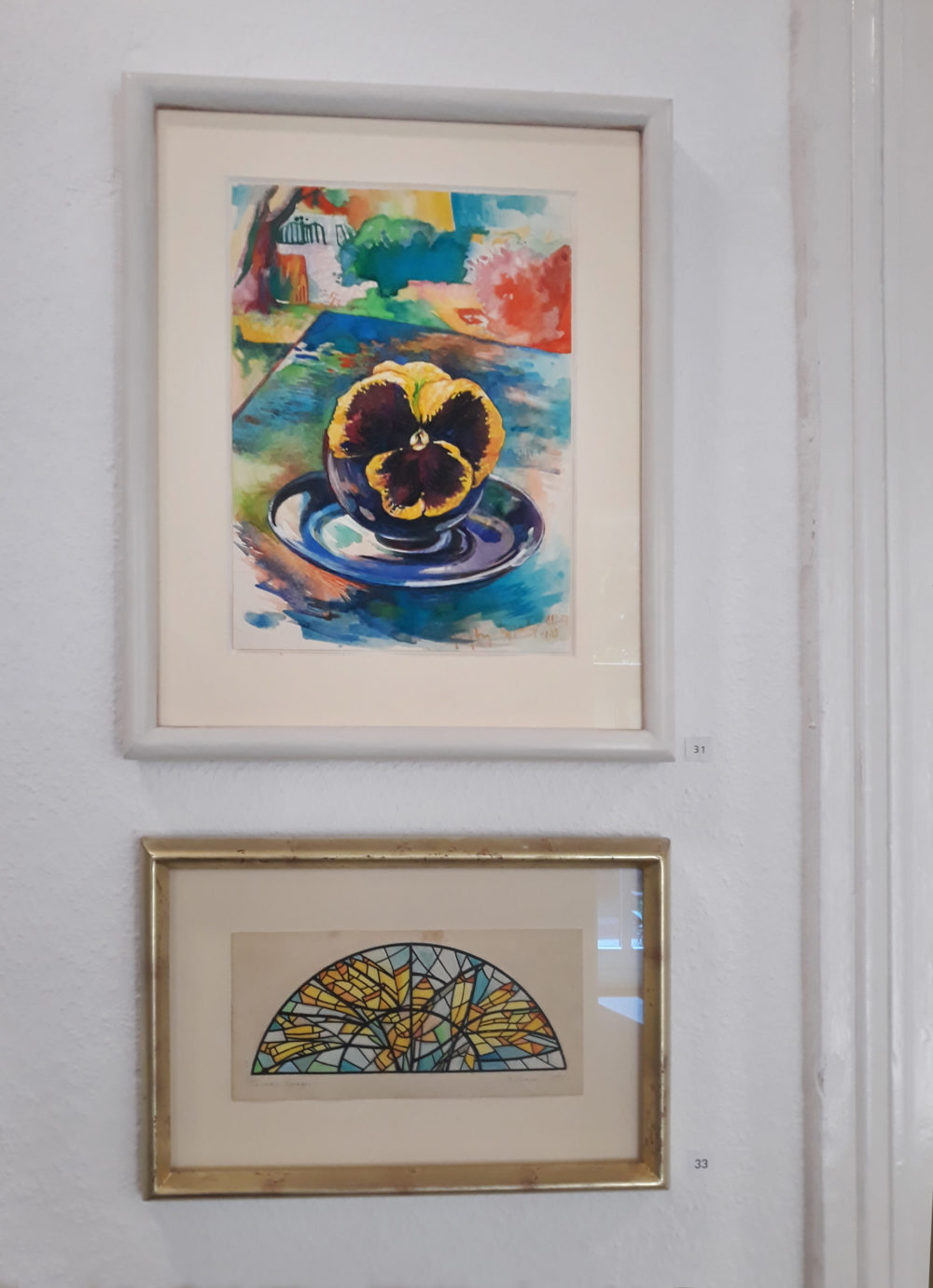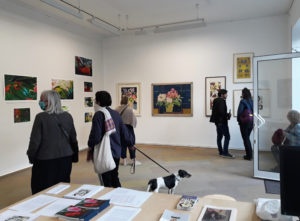
Pansies (top, 1992) in gouache and watercolor (1989) by Archi Galentz
Post-COVID Art Blossoms again in Berlin
by Muriel Mirak-Weissbach
BERLIN — JUNE 4, 2020 – Slowly, cautiously and with painstaking care to ensure the safety and health of visitors, Archi Galentz and Andreas Wolf welcomed art lovers to their gallery in the German capital for the opening of a new exhibition on May 29. It was the first time since the Coronavirus pandemic had shut down normal life in Berlin that people could gather in such a setting. To be sure, guests had to register beforehand and could enter the gallery only five at a time, so that each would always have 20 square meters space. To comply with the regulations, many had to wait a while outside or in the courtyard, with a refreshing drink. Most visitors wore masks, and all had to keep their distance,
Most appropriately, the exhibition was dedicated to flowers, to celebrate the return of spring and the partial return to cultural life. The vernissage also marked the first anniversary of the Gallery Wolf & Galentz’s existence. Thanks to the interest displayed by art lovers in the capital, as well as a German art patron and the Renaissance Foundation in Armenia, the young gallery can continue its work, with exhibitions, research and publications.
“Flowers – Approaches to a Contentious Motif,” is the title of the new show. Why contentious? Anna E. Wilkins, a Germanist who is a member of the gallery team, provides insight in an essay prepared for the exhibition. She quoted Marina Koldobskaja, one of the exhibiting artists, who said it was “considered indecent for a contemporary artist to paint flowers.” So indecent, that to do so might even place the artist’s reputation in jeopardy. Flowers as a subject might seem incompatible with the prevailing tastes and norms in contemporary art, Wilkins explains; more often than not today’s art glorifies the ugly and the incomprehensible, or exalts what is considered politically relevant. Precisely for this reason, to seek the beautiful through art constitutes a challenge.

Vernissage May 29, 2020
The three artists featured in his show have taken up that challenge, adopting different approaches, but all focused on flowers. In the gallery, visitors saw drawings, prints and watercolors by Gisa Hausmann (1942-2015), whose artistic estate is managed by the Wolf-Galentz gallery. The works on display by this Berlin artist depict cultivated flowers, grown in greenhouses, and works in a style, combing print techniques with free brushstrokes, that often recalls the Jugendstil (art nouveau). Marina Koldobskaja (born 1961) from St. Petersburg, works with acrylic, on paper and canvas, and treats flowers in isolation, in flower beds and even in whole fields. Ira Schneider (born 1939) is originally from New York but lives and works in Berlin. Schneider, who was a pioneer in video art in the 1960s and 1970s, uses a concave mirror to photograph flowers, and achieves abstraction through the resulting distortion. As for his choice of subject matter, he has been quoted saying, “Human beings are made up of 67 percent water and 33 percent flowers.”
In the further rooms of the gallery art lovers are treated to works that are part of the gallery’s permanent collection, including etchings, oil or gouache painting, engravings and some ceramics. Among the artists represented are Mariam Aslamanzyan (including a piece she painted in the year 2000 at age 92!), Hermann Bachmann, Brigitta Friedrich, Klaus Fussmann, Archi Galentz, G. von Galentz, Joseph Heeg, Alexander Horn, Thomas Kaemmerer, Philip Mager, Olg Neishtadt, Nazeli Nikogosyan and Jürgen Wittdorf.
The exhibition continues to July 28, and promises to be a success, not despite the floral motif, but perhaps because of it. In her remarks, Wilkins recalled a passage in the memoirs of Gisa Hausmann, referring to a period of personal crisis. While struggling with emotional stress, the artist felt a profound need to deal with floral motifs in her art. A colleague who came to visit her and saw some of the new paintings, “lost her composure,” as she thought that flowers somehow did not fit her view of a serious artist. And yet the surprise was actually an expression of appreciation. A shift had taken place. Indeed, flowers “can rehabilitate through their beauty.” In the current situation, characterized by the social and emotional stress associated with the Corona crisis, beauty — the beauty of flowers — possesses the capacity to heal and rehabilitate.